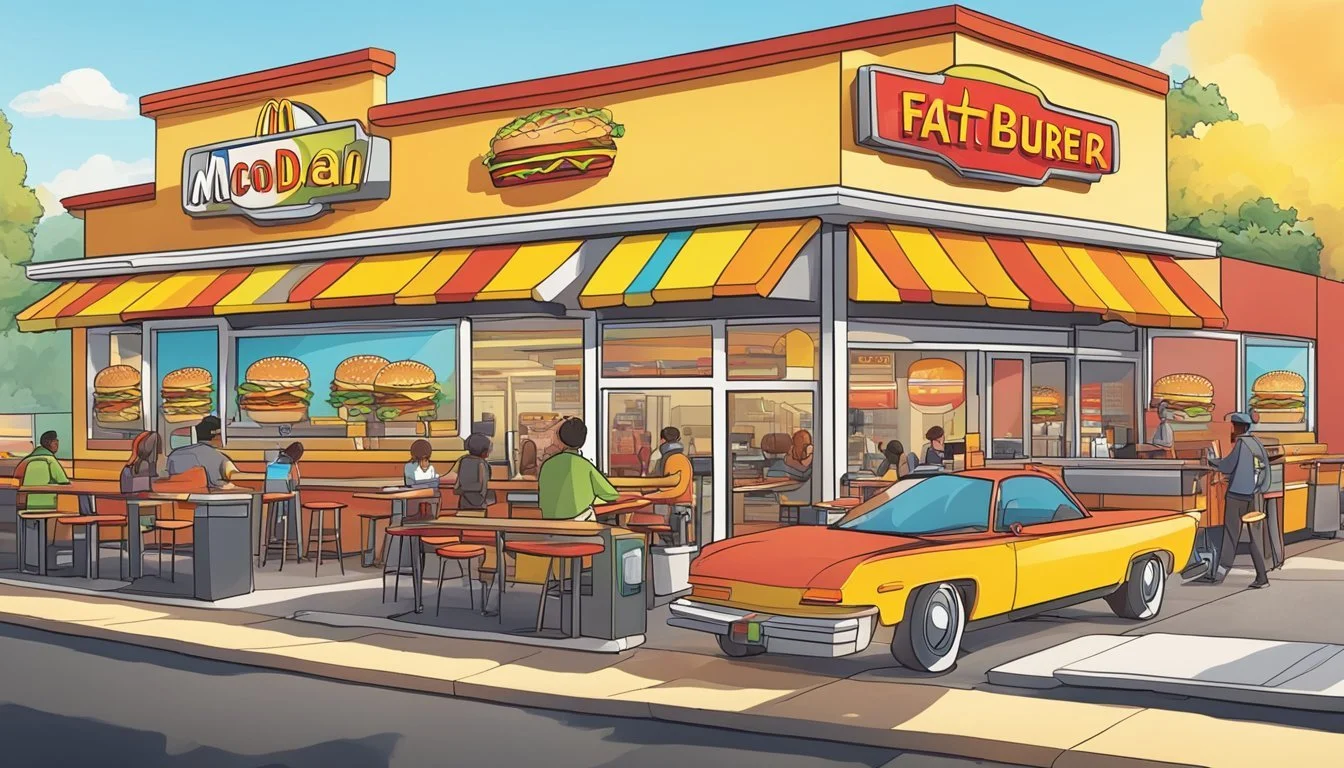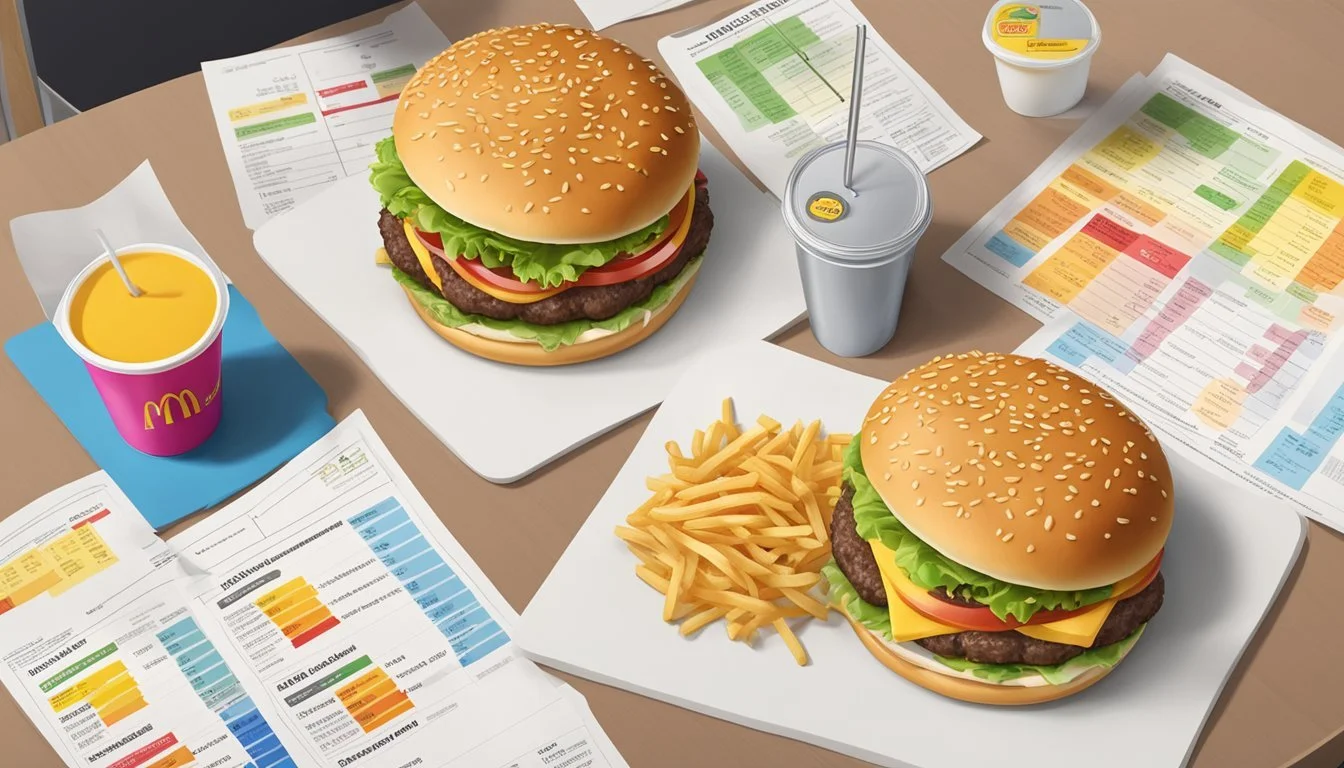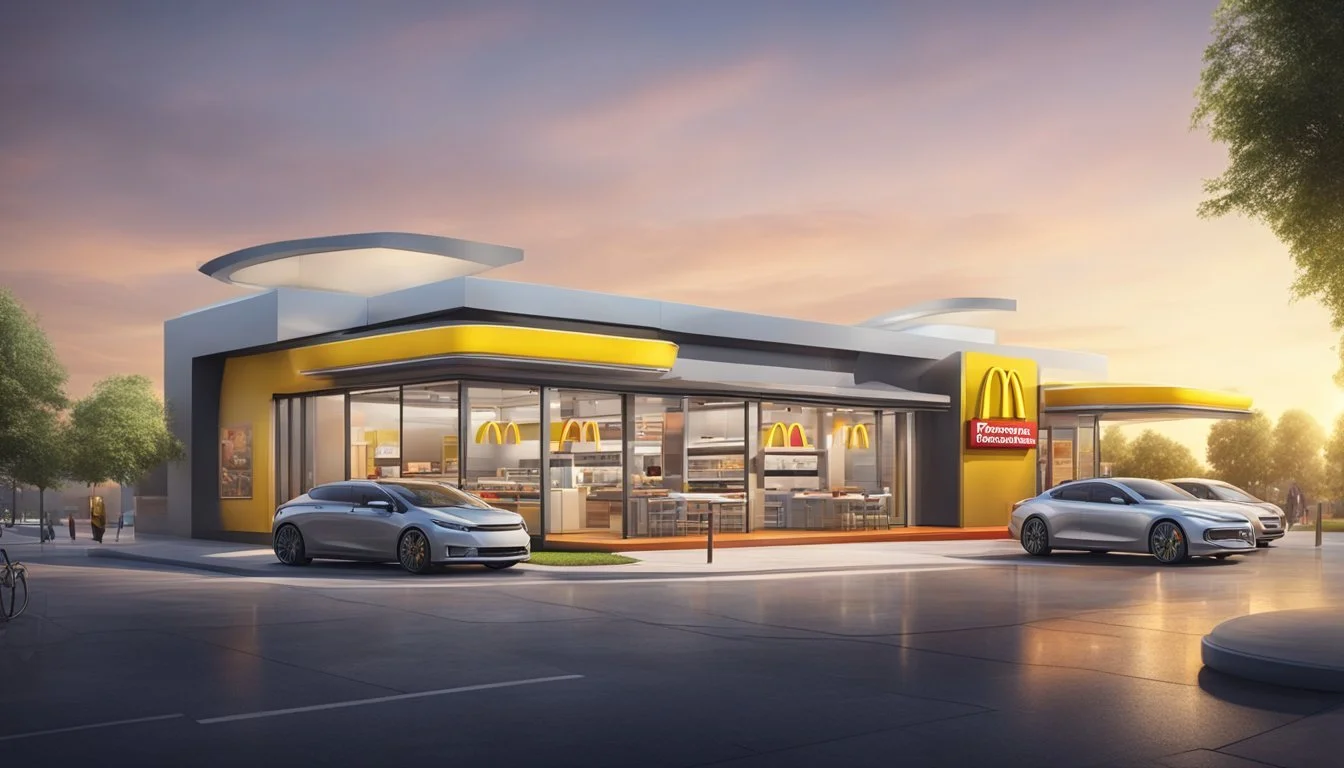McDonald's vs Fatburger
An Unbiased Comparison of Burger Giants
Deciding where to grab a delicious fast food burger often boils down to personal preference and the contenders in the ring: McDonald's and Fatburger. McDonald's is arguably the more ubiquitous option, a global giant known for its speedy service and consistent taste, offering a range of burgers including the iconic Big Mac and the familiar Quarter Pounder. On the other hand, Fatburger, while not as widespread, stakes its claim with a more selective burger menu that prides itself on customizable, made-to-order burgers with fresh ingredients and lean beef, making it a strong contender in the best burger debate.
The fast food world thrives on competition and customer loyalty, and determining which burger joint is superior could be a challenging endeavor. Examining key aspects such as menu variety, burger customization, quality of ingredients, and overall taste, it is necessary to dig into what sets these two chains apart. McDonald's might shine for its quick service and global accessibility, while Fatburger could edge ahead with its emphasis on personalization and quality of patties.
Each establishment offers a distinct experience: McDonald's with its efficient production of crowd-pleasers and widespread presence, and Fatburger with its commitment to build-your-own burger aficionados and emphasis on fresh, lean beef. The battle is not just about the burgers themselves, but also about the dining experience that each brand provides. Are consumers looking for the quick familiarity of a McDonald's drive-thru, or the customizable indulgence of Fatburger's offerings? The answer depends on what the diner values most in their fast food burger journey.
Historical Evolution
Exploring the history of McDonald's and Fatburger reveals a timeline marked by significant growth, marketing milestones, and industry-shaping innovations.
Origins of McDonald's
McDonald's began its journey as a small drive-in restaurant in 1940, founded by Richard and Maurice McDonald in San Bernardino, California. Originally, it operated as a barbecue joint, but the McDonald brothers quickly recognized the potential of the fast food model. By focusing on a limited menu and implementing the revolutionary "Speedee Service System," they transformed their establishment into the first McDonald's hamburger stand in 1948. This set a new course for the fast food industry, prioritizing speed and efficiency.
Menu Evolution: From its original nine-item menu, McDonald's expanded its offerings, always emphasizing the iconic hamburger.
Franchise Growth: Ray Kroc joined as a franchise agent in 1955 and opened the first franchise in Des Plaines, Illinois. Under his vision, the McDonald's franchise rapidly grew into a global fast food chain, with over 100 locations by 1959.
Founding of Fatburger
Fatburger entered the fast food scene in 1947 when Lovie Yancey opened her first burger stand in Los Angeles, California. She coined the name "Fatburger" by promoting the idea of a bigger and juicier hamburger. Unlike McDonald's systematized operations, Fatburger focused on a "cooked-to-order" approach, catering to customers who preferred a more custom-made burger experience.
Branding: Fatburger's marketing centered on its generously sized burgers and fresh ingredients, differentiating itself as a premium yet fast service restaurant.
Expansion: Initially a West Coast favorite, Fatburger began franchising in the 1980s, currently with locations in multiple countries, retaining the essence of the original stand's appeal.
Both McDonald's and Fatburger have pioneered distinct paths in fast-food history, each with their strategies, marketing, and brand evolution which have shaped their respective places in the industry.
Menu Offerings Comparison
When comparing McDonald's to Fatburger, one examines the variety, quality, and uniqueness of their menu options. Each brand has distinctive offerings that cater to different preferences and dietary needs.
Signature Burgers
McDonald's: Known for the Big Mac, this iconic burger features two beef patties, special sauce, lettuce, cheese, pickles, and onions on a sesame seed bun. Another staple is the Quarter Pounder, which boasts a quarter-pound of beef with cheese, ketchup, mustard, pickles, and onions.
Fatburger: The Fatburger itself is known for being customizable. Customers can choose from a variety of sizes, ranging from the small to the XXXL, each served with lettuce, tomato, mustard, relish, pickles, onions, and mayonnaise on a toasted bun. They take pride in their fresh, never frozen, beef patties.
Diversity of Menu
McDonald's offers a broad menu that includes chicken sandwiches, fish, salads, a variety of breakfast items, and Happy Meals for children. They also offer vegan options, such as a vegan burger in some locations.
Fatburger, while primarily known for their burgers, has expanded its menu to include chicken, turkey, and vegan options like the Impossible Burger. They also have a range of add-on toppings to further customize your burger, giving patrons the chance to tailor their meal to their taste.
Beverage and Sides
Both restaurants offer a selection of soft drinks, with Coke products reigning at McDonald's. For sides, McDonald's is famous for its french fries, which have become almost as iconic as the burgers. They also provide healthier options such as apple slices or a fruit bag.
Fatburger also serves french fries but differs by offering sweet potato fries and onion rings as alternatives. The beverage menu includes traditional milkshakes, blending in an old-fashioned diner experience with flavors like chocolate, vanilla, and strawberry.
McDonald's and Fatburger each provide a unique dining experience through their menu offerings, catering to a wide range of tastes and dietary preferences.
Quality and Taste
When comparing McDonald's and Fatburger, their respective approaches to burger quality and taste are pivotal. Each brand has signature elements, from the seasoning of the patty to the distinct sauces they offer.
Ingredients Quality
McDonald's is recognized for the consistency in its ingredients across the globe. The chain has recently taken steps to improve the quality of its burgers. Ingredients like the beef patty are free from fillers, additives, and preservatives. In terms of freshness, McDonald's has announced commitments that customers can taste the difference, suggesting improvements in ingredient quality by 2024.
Fatburger's reputation hinges on its commitment to quality, featuring 100 percent pure lean beef in their patties. The ingredients in a Fatburger are typically considered fresh, as Fatburger prides itself on never using frozen meat or produce.
Flavor Profiles
McDonald's burgers, such as the iconic Big Mac, are known for their special Big Mac sauce that adds a unique flavor profile to the burger, alongside the melted cheese. The flavor of a McDonald's burger is a blend of beef seasoned with a simple salt and pepper mix.
Fatburger offers a more robust flavor experience, with the Fatburger showcasing a beef patty that is juicy and full-flavored. Toppings such as lettuce, tomato, and onions are added fresh, while the relish, mayonnaise, and mustard bring additional zing. The burger's seasoning complements the natural beef flavor, enhancing the overall taste.
By offering quality ingredients and well-rounded flavors, both McDonald's and Fatburger make a strong case for their place in the fast-food burger hierarchy.
Consumer Experience
In considering McDonald's and Fatburger, the consumer experience hinges on service speed and the overarching atmosphere and branding, both of which play crucial roles in shaping customer perceptions and satisfaction.
Service Speed
McDonald's is renowned for its rapid service, often leveraging an efficient drive-thru system that moves customers from order to meal in just minutes. According to industry standards, McDonald’s consistently outperforms many of its competitors in this area. On the other side, Fatburger is generally seen as a more premium fast food experience, and while it might not match the speed of McDonald's, it aims to deliver freshly made-to-order burgers, which naturally takes a bit longer.
McDonald's:
Drive-thru system: Highly efficient
Order to meal time: Very fast
Fatburger:
Service type: Made-to-order
Wait time: Longer than McDonald's
Atmosphere and Branding
The environment at McDonald's showcases a highly recognizable brand identity, with interiors designed for quick dining and family-friendly visits. Through decades of successful ad campaigns and consistent branding, including characters like Ronald McDonald, they have created a globally unified brand experience. Fatburger, although lesser known than giants like McDonald's and Burger King, offers a unique dining ambiance that feels closer to a traditional diner, with more attention to the sit-down experience. Their branding focuses on the quality and size of their burgers, setting them apart as a 'bigger, heartier' option in the fast food scene.
McDonald's:
Interior: Family-friendly, quick-dining oriented
Brand identity: Strong, consistent through commercials and ad campaigns
Fatburger:
Interior: Diner-like, inviting sit-down experience
Brand identity: Focus on quality and size
Nutritional Value
When comparing McDonald's and Fatburger, it is important to consider the nutritional value of their offerings, focusing on elements such as caloric content and the availability of dietary options. These factors are crucial for customers who are mindful of their food choices due to health considerations or specific diet requirements.
Caloric Information
McDonald's provides a range of burgers with varying calorie counts. For example, the McDonald's Hamburger contains approximately 250 calories, making it one of the lower-calorie burger options. On the other end of the spectrum, the Big Mac has approximately 540 calories. Fatburger, while not explicitly mentioned for caloric data, also offers a variety of calorie options depending on the size of the burger and additional toppings.
Dietary Options
Both burger joints cater to customers with specific dietary needs. McDonald's has incorporated several options, such as:
Salad Options: For customers seeking low-carb alternatives.
Gluten-Free: Customers can opt for burgers without the bun.
Lettuce Wrap: A substitute for the traditional bun for a lower-calorie, low-carb option.
Fatburger also accommodates various dietary preferences with options like:
Vegan: The Impossible Burger, a plant-based alternative.
Lettuce Wrap: Available for those avoiding traditional buns.
Gluten-Free: Offering a gluten-free bun or a burger in a bowl to skip the bun entirely.
Both establishments provide nutritional information to assist customers in making informed decisions based on their dietary needs, whether they require vegan, gluten-free, or low-carb options.
Market Position
In exploring the market positions of McDonald's and Fatburger, one must consider factors such as brand recognition and competitive landscape. Both entities have carved distinctive identities within the fast-food industry, impacting their market share and popularity.
Brand Recognition
McDonald's is a global powerhouse in the fast-food industry, boasting immense brand recognition. As the world's largest burger vendor and the largest fast-food chain globally, its golden arches symbol is iconic. McDonald's brand image is carefully crafted to resonate with consumers, and its consistent marketing efforts are designed to maintain a strong connection with its customer base.
On the other hand, Fatburger holds a different kind of appeal. Known for its signature item, the Fatburger, it has cultivated a reputation for offering hefty burgers with lean beef. Although Fatburger may not compete with McDonald's in terms of global presence, it has established itself as a cult favorite among burger enthusiasts, particularly in locations where it operates.
Competition and Rivalries
The fast-food landscape is marked by intense rivalries, with chains continually vying for a greater slice of the market share. McDonald's has faced competition from various quarters, as indicated by its historical adversarial campaigns with Burger King. However, it remains a distant ahead in the burger power rankings.
Fatburger competes in a different segment, focusing less on the scale of operations and more on the quality and size of its burgers. While it does not engage in rivalries of the same magnitude as McDonald's, it has its share of competition within the niche it occupies. This positioning allows Fatburger to maintain a solid presence in the power rankings for chain burger restaurants, even if it does not rival McDonald's in terms of sales volume or size.
Future and Innovation
The fast-food industry is constantly evolving with new technology and market strategies. McDonald's and Fatburger are actively leveraging innovations in science and automation, along with aggressive marketing tactics, to push for global expansion and better engage with the mobile ordering trend.
Expansion Plans
McDonald's has consistently pursued growth on a global scale, focusing on entering new markets and strengthening its presence where it already operates. It aims to do so while integrating local tastes and preferences to cater to a diverse customer base. Fatburger, though smaller in footprint, has shown interest in expanding their franchise, targeting new domestic and international markets to establish a global presence.
McDonald's: Continues to open new restaurants worldwide, adapting menus per region.
Fatburger: Seeks to expand both in the United States and globally, with a preference for lean beef products that may appeal to health-conscious consumers.
Technological Advancements
Both burger joints are embracing technological advancements to stay ahead. McDonald's is investing heavily in automation and AI to streamline its operations, from kiosks for ordering to AI-driven drive-thrus. It's also boosting its mobile ordering system to enhance customer experience and increase sales. Fatburger is adopting similar technologies but also focuses on maintaining the fresh, made-to-order quality that their customers expect.
McDonald's: Implements automated ordering systems and AI to improve efficiency and reduce wait times.
Fatburger: Integrates technology that balances automation with customer expectations for fresh, custom-made burgers.
Conclusion
When deciding between McDonald's and Fatburger for a better burger experience, several factors merit consideration. McDonald's is globally recognized for its consistency and familiar taste profile. With a hamburger containing 250 calories, and providing 13g of protein, customers find a reliable option for a lower-calorie fast-food meal.
Fatburger, on the other hand, caters to those who prefer a more personalized burger. Customers can select from a variety of free toppings ranging from lettuce and tomatoes to grilled onions and jalapenos, ensuring each burger meets their specific tastes. The nutritional information for Fatburger's offerings, however, tends to list higher in terms of calories and fat, making it a potentially less optimal choice for those seeking leaner options.
In terms of quality and experience, Fatburger's made-to-order approach with 100 percent beef patties and a selection of fresh toppings may offer a more restaurant-like experience. Conversely, McDonald's streamlined and quick service ensures a fast and efficient purchase, with the trade-off being less customizable burgers.
This analysis doesn’t make a definitive choice for the customer but rather highlights the attributes of both establishments. McDonald’s may win on nutritional value and speed, while Fatburger shines with its customizable quality and flavor experience. Ultimately, the decision rests on individual preference and priorities when choosing between the heartiness of a Fatburger and the classic simplicity of a McDonald's hamburger.








